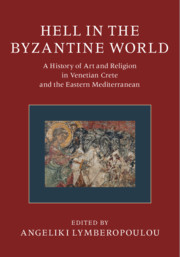 Hell in the Byzantine World
Hell in the Byzantine World Book contents
- Hell in the Byzantine World
- Hell in the Byzantine World
- Copyright page
- Dedication
- Dedication
- Contents
- Figures and Maps
- Preface
- Acknowledgements
- Editorial Policy
- Volume 1
- Introduction
- Part I Crete
- Part II Eastern Mediterranean
- 5 When the Visual Order Was Established
- 6 Damned in Hell, Damned in the Church
- 7 Images of Hell and the Afterlife in the Churches of Lakonia
- 8 Hell in the ‘Sweet Land’
- Volume 2
- Bibliography
- Index
7 - Images of Hell and the Afterlife in the Churches of Lakonia
from Part II - Eastern Mediterranean
Published online by Cambridge University Press: 02 October 2021
- Hell in the Byzantine World
- Hell in the Byzantine World
- Copyright page
- Dedication
- Dedication
- Contents
- Figures and Maps
- Preface
- Acknowledgements
- Editorial Policy
- Volume 1
- Introduction
- Part I Crete
- Part II Eastern Mediterranean
- 5 When the Visual Order Was Established
- 6 Damned in Hell, Damned in the Church
- 7 Images of Hell and the Afterlife in the Churches of Lakonia
- 8 Hell in the ‘Sweet Land’
- Volume 2
- Bibliography
- Index
Summary
Sharon E. J. Gerstel and Panayotis S. Katsafados explore images of Hell in churches of the 12th and 14th centuries in Lakonia, the southern Peloponnese, considering the transition of images of sinners from those collectively punished to those individually tormented. After examining the traces of images of Hell in two churches in Mystras and Chrysapha, the authors turn to more humble structures in Epidauros Limera and the Mani, where the representation of sinners is related to village life. The depicted priests, farmers, and women engage in sins that destabilised the village’s agrarian economy and disrupted social order, suggesting that, at a local level, warnings about behaviour in the earthly world were as critical to the community as warnings about salvation in the world to come. Rare images of figures labelled as ‘potion makers’ and ‘witches’ indicate attempts of the Church to regulate dangerous activities that contravened ecclesiastical law and teachings. Representations of usurers, falsifiers of documents, and those who cheat at the scales hint at the challenges that plagued communities in financial hardship. Such depictions continue in the region in the post-Byzantine period, though with increasing complexity, demonstrating a long-term interest in the use of imagery for social commentary.
- Type
- Chapter
- Information
- Hell in the Byzantine WorldA History of Art and Religion in Venetian Crete and the Eastern Mediterranean, pp. 310 - 345Publisher: Cambridge University PressPrint publication year: 2020


